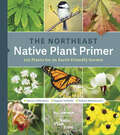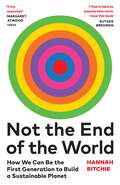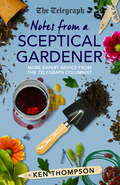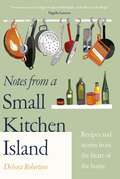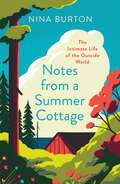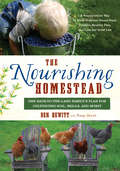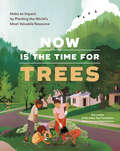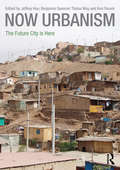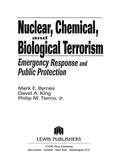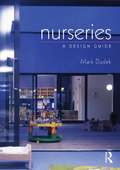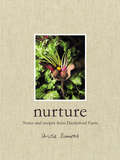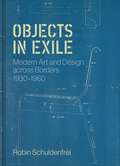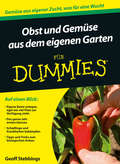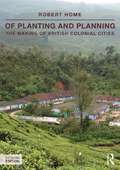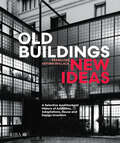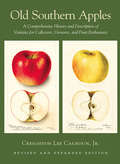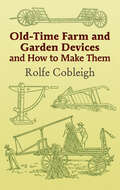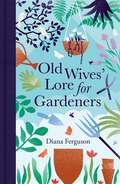- Table View
- List View
The Northeast Native Plant Primer: 235 Plants for an Earth-Friendly Garden
by Uli Lorimer Native Plant TrustBring your garden to life—and life to your garden Do you want a garden that makes a real difference? Choose plants native to our Northeast region. The rewards will benefit you, your yard, and the environment—from reducing maintenance tasks to attracting earth-friendly pollinators such as native birds, butterflies, and bees. Native plant expert Uli Lorimer of the Native Plant Trust makes adding these superstar plants easier than ever before, with proven advice that every home gardener can follow. This incomparable sourcebook includes 235 recommended native trees, shrubs, vines, ferns, wildflowers, grasses, sedges, and annuals. It&’s everything you need to know to create a beautiful and beneficial garden. This must-have handbook is for gardeners in Connecticut, Delaware, Maine, Massachusetts, New Hampshire, New Jersey, New York, eastern Ohio, Pennsylvania, Rhode Island, and Vermont.
Not the End of the World: How We Can Be the First Generation to Build a Sustainable Planet
by Hannah Ritchie‘A book for anyone who finds it difficult to believe in a better future’ THE TIMESFeeling anxious, powerless, or confused about the future of our planet? This book will transform how you see our biggest environmental problems -- and how we can solve them.A STYLIST BEST NON-FICTION 2024 * A GUARDIAN BIGGEST FICTION AND NON-FICTION FOR 2024 * A WATERSTONES ‘BOOK YOU NEED TO READ IN 2024’ * A GUARDIAN ‘FIVE GREAT READS’ We are bombarded by doomsday headlines that tell us the soil won't be able to support crops, fish will vanish from our oceans, that we should reconsider having children.But in this bold, radically hopeful book, data scientist Hannah Ritchie argues that if we zoom out, a very different picture emerges. The data shows we've made so much progress on these problems, and so fast, that we could be on track to achieve true sustainability for the first time in history.Packed with the latest research, practical guidance and enlightening graphics, this book will make you rethink almost everything you've been told about the environment, from the virtues of eating locally and living in the countryside, to the evils of overpopulation, plastic straws and palm oil. It will give you the tools to understand what works, what doesn't and what we urgently need to focus on so we can leave a sustainable planet for future generations.These problems are big. But they are solvable. We are not doomed. We can build a better future for everyone. Let's turn that opportunity into reality.‘I find it hard to express how much I love this book’ RUTGER BREGMAN * 'An unmissable myth-busting book to save our planet – read it' TIM SPECTOR
Notes From a Sceptical Gardener: More expert advice from the Telegraph columnist
by Ken ThompsonWhat is the best way to kill weeds in paving? How scared should we really be of Japanese knotweed? And what is a weed anyway? Biologist Ken Thompson set out to write a different kind of gardening column, one that tackles what he calls ‘the grit in the gardening oyster’. In this new collection he takes a look at some of the questions faced by gardeners everywhere in a bid to sort the truth from the wishful thinking. Why are the beaks of British great tits getting longer? Which common garden insect owns a set of metal-tipped running spikes? Why might growing orange petunias land you in hot water? Are foxes getting bigger? How do you stop the needles falling off your Christmas tree? This expert’s miscellany of (mostly) scientifically-tested garden lore will make you look at your garden through fresh eyes.
Notes from a Small Kitchen Island: ‘I want to eat every single recipe in this book’ Nigella Lawson
by Debora RobertsonDiscover the cookbook you'll never want to live without, filled with the secrets to creating delicious home-cooked meals every single day'I am so greedily impatient for this book. I want to read it. I want to cook from it' NIGELLA LAWSON'There are wonderful tales and recipes here, and lots of wisdom. It's approachable, anchored in real life and a joy to read. I want more' DIANA HENRY'A wonderful book full of inspiring, simple and time-saving recipes. This should be an everyday book for everybody' TOM KERRIDGE_________Debora Robertson, home cook and renowned food writer, tells how, from the least promising of culinary starts, she learned to love cooking and transformed her cosy kitchen into the beating heart of her home.Through her stories and recipes, she will whisk you away to hot summers in Languedoc and balmy weeknights in London, revealing the life-changing dishes that made her. Bound together with life- and dinner-saving lessons, Debora has written the essential kitchen companion for every home cook.From the tastes of Debora's childhood to the recipes she discovered on her travels, to the food she cooks every day . . .· Leek and ham hock steamed pudding· Slow roast lamb with Durham salad· Meemaw's Texan margarita pie· The best recipe for roast chicken· Delicious plum cakeDebora will take you by the hand and tell you everything you'll ever need to know about cooking food you'll love time and time again._________ 'I want to eat every single recipe in this book - even the two for dogs!' NIGELLA LAWSON
Notes from a Summer Cottage: The Intimate Life Of The Outside World
by Nina Burton‘I went for a walk around the garden. A great tit warbled above a patch of coltsfoot. I felt a thousand discoveries awaited…'
The Nourishing Homestead: One Back-to-the-Land Family’s Plan for Cultivating Soil, Skills, and Spirit
by Ben Hewitt Penny HewittA practiculture way to grow nutrient-dense food, produce healthy fats, and live the good life The Nourishing Homestead tells the story of how we can create truly satisfying, permanent, nourished relationships to the land, nature, and one another. The Hewitts offer practical ways to grow nutrient-dense food on a small plot of land, and think about your farm, homestead, or home as an ecosystem. Much of what the Hewitts have come to understand and embrace about their lives of deep nourishment is informed by their particular piece of land and local community in northern Vermont, but what they have gleaned is readily transferable to any place—whether you live on 4 acres, 40 acres, or in a 400-square-foot studio apartment. Ben and Penny (and their two sons) maintain copious gardens, dozens of fruit and nut trees and other perennial plantings, as well as a pick-your-own blueberry patch. In addition to these cultivated food crops, they also forage for wild edibles, process their own meat, make their own butter, and ferment, dry, and can their own vegetables. Their focus is to produce nutrient-dense foods from vibrant, mineralized soils for themselves and their immediate community. They are also committed to sharing the traditional skills that support their family, helping them be self-sufficient and thrive in these uncertain times. Much of what the Hewitts are attempting on their homestead is to close the gaps that economic separation has created in our health, spirit, and skills. Ben uses the term “practiculture” to describe his family’s work with the land—a term that encompasses the many practical life skills and philosophies they embody to create a thriving homestead, including raw-milk production, soil remediation, wildcrafting, Weston A. Price principles, bionutrient-dense farming, permaculture, agroforestry, traditional Vermont hill farming, and more. The Nourishing Homestead also includes information on deep nutrition, the importance of good fats, and integrating children into the work of a homestead. The Hewitts’ story is reminiscent of The Good Life, by Helen and Scott Nearing, and is sure to inspire a new generation of homesteaders, or anyone seeking a simpler way of life and a deeper connection to the world.
Now Is the Time for Trees: Make an Impact by Planting the Earth's Most Valuable Resource
by Arbor Day Foundation Dan Lambe&“Celebrates the power of trees to oxygenate the planet, purify water and air, lower city temperatures, provide habitat, nurture the soul, and provide essential food sources.&” —Booklist Trees and forests are the number one nature-based solution for reversing the negative effects of a changing climate. If ever there was a time to be planting trees, that time is now. Inspired by a collective sense of urgency, a global movement to plant trees is gaining momentum. To move the needle, we need to act on a massive scale and plant millions of trees today to have a measurable and lasting impact on billions of lives tomorrow. In Now Is the Time for Trees, the experts at the Arbor Day Foundation will inspire you to do your part by showing you everything you need to know to plant trees at home or in your community. From advice on choosing the right size and type of tree to tried-and-true tips for planting success, this book will help you plant a tree today and leave your own legacy of hope. Equal parts inspiration and advocacy, Now Is the Time for Trees is a rousing call for environmental action and a must-have book for nature lovers everywhere.
Now Urbanism: The Future City is Here
by Jeffrey Hou Benjamin Spencer Thaisa Way Ken YocomAfter more than a century of heroic urban visions, urban dwellers today live in suburban subdivisions, gated communities, edge cities, apartment towers, and slums. The contemporary cities we know are more often the embodiment of unexpected outcomes and unintended consequences rather than visionary planning. As an alternative approach for rethinking and remaking today’s cities and regions, this book explores the intersections of critical inquiry and immediate, substantive actions. The contributions inside recognize the rich complexities of the present city not as barriers or obstacles but as grounds for uncovering opportunity and unleashing potential. Now Urbanism asserts that the future city is already here. It views city making as grounded in the imperfect, messy, yet rich reality of the existing city and the everyday purposeful agency of its dwellers. Through a framework of situating, grounding, performing, distributing, instigating, and enduring, these contributions written by a multidisciplinary group of practitioners and scholars illustrate specificity, context, agency, and networks of actors and actions in the re-making of the contemporary city.
Now Urbanism: The Future City is Here
by Jeffrey Hou Benjamin Spencer Thaisa Way Ken YocomAfter more than a century of heroic urban visions, urban dwellers today live in suburban subdivisions, gated communities, edge cities, apartment towers, and slums. The contemporary cities we know are more often the embodiment of unexpected outcomes and unintended consequences rather than visionary planning. As an alternative approach for rethinking and remaking today’s cities and regions, this book explores the intersections of critical inquiry and immediate, substantive actions. The contributions inside recognize the rich complexities of the present city not as barriers or obstacles but as grounds for uncovering opportunity and unleashing potential. Now Urbanism asserts that the future city is already here. It views city making as grounded in the imperfect, messy, yet rich reality of the existing city and the everyday purposeful agency of its dwellers. Through a framework of situating, grounding, performing, distributing, instigating, and enduring, these contributions written by a multidisciplinary group of practitioners and scholars illustrate specificity, context, agency, and networks of actors and actions in the re-making of the contemporary city.
Nuclear, Chemical, and Biological Terrorism: Emergency Response and Public Protection
by Mark E. Byrnes David A. King Philip M. Tierno Jr.This book provides guidance on measures that should be considered to protect human lives from terrorist activities involving nuclear, chemical, and biological weapons. It provides a historical summary of the development and use of these weapons, and continues with a detailed discussion of the types of radiation and warfare agents that are available
Nuclear, Chemical, and Biological Terrorism: Emergency Response and Public Protection
by Mark E. Byrnes David A. King Philip M. Tierno Jr.This book provides guidance on measures that should be considered to protect human lives from terrorist activities involving nuclear, chemical, and biological weapons. It provides a historical summary of the development and use of these weapons, and continues with a detailed discussion of the types of radiation and warfare agents that are available
Nurseries: A Design Guide
by Mark DudekArchitecture can inspire young children; the very shape and form of a daycare center can not only stimulate their imagination but can help children form strong relationships and help promote development. This design guide presents all the elements of building design that combine to create the very best environment for young children and the people who work with them, including building materials, multi-functional spaces and design scaled to suit small children.
Nurseries: A Design Guide
by Mark DudekArchitecture can inspire young children; the very shape and form of a daycare center can not only stimulate their imagination but can help children form strong relationships and help promote development. This design guide presents all the elements of building design that combine to create the very best environment for young children and the people who work with them, including building materials, multi-functional spaces and design scaled to suit small children.
Nurture: Notes and Recipes from Daylesford Farm
by Carole BamfordOver 40 years ago, Carole Bamford began a journey towards a more conscious way of life. What began as a desire to make a small difference to the health and future of our planet has grown from a collection of empty barns, bare fields and a small herd of dairy cows, to become Daylesford Organic, one of the most sustainable farms in the UK.Nurture tells the story of how and why it all began and brings to life the principles, ideas and beliefs that have made Daylesford what it is today. From sustainable farming to holistic health, Nurture shares Carole Bamford’s vision for a more mindful way of life and how we can all nourish our bodies, mind and spirit in a simple and balanced way. At the heart of Daylesford is its connection to the land and the book also celebrates the bountiful organic produce it reaps with a selection of seasonal recipes. Packed with flavour and nourishing ingredients, choose from colourful salads and hearty stews, indulgent puddings, meals for special occasions and food for those times when you need an additional boost of nutrients. Nurture is a celebration of the bounty that nature provides, and a reminder that we must all take care of the land we live off, so that future generations can enjoy its riches too.
Objects in Exile: Modern Art and Design across Borders, 1930–1960
by Robin SchuldenfreiAn essential examination of how emigration and resettlement defined modernismIn the fraught years leading up to World War II, many modern artists and architects emigrated from continental Europe to the United States and Britain. The experience of exile infused their modernist ideas with new urgency and forced them to use certain materials in place of others, modify existing works, and reconsider their approach to design itself. In Objects in Exile, Robin Schuldenfrei reveals how the process of migration was crucial to the development of modernism, charting how modern art and architecture was shaped by the need to constantly face—and transcend—the materiality of things.Taking readers from the prewar era to the 1960s, Schuldenfrei explores the objects these émigrés brought with them, what they left behind, and the new works they completed in exile. She argues that modernism could only coalesce with the abandonment of national borders in a process of emigration and resettlement, and brings to life the vibrant postwar period when avant-garde ideas came together and emerged as mainstream modernism. Examining works by Walter Gropius, László Moholy-Nagy, Lucia Moholy, Herbert Bayer, Anni and Josef Albers, and others, Schuldenfrei demonstrates the social impact of art objects produced in exile.Shedding critical light on how the pressures of dislocation irrevocably altered the course of modernism, Objects in Exile shows how artists and designers, forced into exile by circumstances beyond their control, changed in unexpected ways to meet the needs and contexts of an uncertain world.
Objects in Exile: Modern Art and Design across Borders, 1930–1960
by Robin SchuldenfreiAn essential examination of how emigration and resettlement defined modernismIn the fraught years leading up to World War II, many modern artists and architects emigrated from continental Europe to the United States and Britain. The experience of exile infused their modernist ideas with new urgency and forced them to use certain materials in place of others, modify existing works, and reconsider their approach to design itself. In Objects in Exile, Robin Schuldenfrei reveals how the process of migration was crucial to the development of modernism, charting how modern art and architecture was shaped by the need to constantly face—and transcend—the materiality of things.Taking readers from the prewar era to the 1960s, Schuldenfrei explores the objects these émigrés brought with them, what they left behind, and the new works they completed in exile. She argues that modernism could only coalesce with the abandonment of national borders in a process of emigration and resettlement, and brings to life the vibrant postwar period when avant-garde ideas came together and emerged as mainstream modernism. Examining works by Walter Gropius, László Moholy-Nagy, Lucia Moholy, Herbert Bayer, Anni and Josef Albers, and others, Schuldenfrei demonstrates the social impact of art objects produced in exile.Shedding critical light on how the pressures of dislocation irrevocably altered the course of modernism, Objects in Exile shows how artists and designers, forced into exile by circumstances beyond their control, changed in unexpected ways to meet the needs and contexts of an uncertain world.
Obst und Gemüse aus dem eigenen Garten für Dummies (Für Dummies)
by Geoff StebbingsFrisches Obst und Gemüse aus dem eigenen Garten Mal eben in den Garten gehen und ein paar Beeren naschen, die selbst angebauten Bohnen ernten oder Zwetschgenkuchen mit Früchten vom eigenen Baum backen − gefällt Ihnen die Vorstellung? Dieses praktische Handbuch gibt Ihnen zahlreiche Tipps und Tricks, wie Sie das ganze Jahr lang leckeres, ernte - frisches Obst und Gemüse aus dem eigenen Garten genießen können: von der Wahl des Werkzeugs über die Auswahl der Pflanzen und Tipps zum biologischen Anbau bis zur ersten Ernte. Geoff Stebbings gibt Ihnen nützliche Ratschläge an die Hand, damit Sie sofort mit der eigenen Gartenarbeit beginnen können und in kurzer Zeit ein erfolgreicher Hobbygärtner werden.
Of Planting and Planning: The making of British colonial cities (Planning, History and Environment Series)
by Robert Home‘At the centre of the world-economy, one always finds an exceptional state, strong, aggressive and privileged, dynamic, simultaneously feared and admired.’ - Fernand Braudel, Civilization and Capitalism, 15th–18th Centuries This, surely, is an apt description of the British Empire at its zenith. Of Planting and Planning explores how Britain used the formation of towns and cities as an instrument of colonial expansion and control throughout the Empire. Beginning with the seventeenth-century plantation of Ulster and ending with decolonization after the Second World War, Robert Home reveals how the British Empire gave rise to many of the biggest cities in the world and how colonial policy and planning had a profound impact on the form and functioning of those cities. This second edition retains the thematic, chronological and interdisciplinary approach of the first, each chapter identifying a key element of colonial town planning. New material and illustrations have been added, incorporating the author's further research since the first edition. Most importantly, Of Planting and Planning remains the only book to cover the whole sweep of British colonial urbanism.
Of Planting and Planning: The making of British colonial cities (Planning, History and Environment Series)
by Robert Home‘At the centre of the world-economy, one always finds an exceptional state, strong, aggressive and privileged, dynamic, simultaneously feared and admired.’ - Fernand Braudel, Civilization and Capitalism, 15th–18th Centuries This, surely, is an apt description of the British Empire at its zenith. Of Planting and Planning explores how Britain used the formation of towns and cities as an instrument of colonial expansion and control throughout the Empire. Beginning with the seventeenth-century plantation of Ulster and ending with decolonization after the Second World War, Robert Home reveals how the British Empire gave rise to many of the biggest cities in the world and how colonial policy and planning had a profound impact on the form and functioning of those cities. This second edition retains the thematic, chronological and interdisciplinary approach of the first, each chapter identifying a key element of colonial town planning. New material and illustrations have been added, incorporating the author's further research since the first edition. Most importantly, Of Planting and Planning remains the only book to cover the whole sweep of British colonial urbanism.
Öffentliche Kunst, Kunst im öffentlichen Raum Niederösterreich, Band 8: / Public Art Lower Austria, Volume 8 (Veröffentlichte Kunst. Kunst im öffentlichen Raum Niederösterreich Public Art Lower Austria #8)
Kunst im öffentlichen Raum in Niederösterreich ist ein einzigartiges Modell, das international höchste Anerkennung findet. Die im ländlichen und kleinstädtischen Raum entstandenen Projekte bedeutender, aber auch junger unbekannter KünstlerInnen setzen sich mit der Landschaft, der Kulturgeschichte und der Architektur auseinander oder entstanden auf der Basis von sozialer und wissenschaftlicher Recherche. Der vorliegende Band dokumentiert die Projekte der Jahre 2004 – 2006. Neben der Projektdokumentation äußern sich Experten unterschiedlichster Bereiche in einer kunstwissenschaftlichen und theoretischen Diskussion zur "Gestaltung von Kreisverkehren", ein Thema brisanter Aktualität in der Gestaltung von Landschaft und Umgebung.
Old Buildings, New Ideas: A Selective Architectural History of Additions, Adaptations, Reuse and Design Invention
by Françoise Astorg BollackSome architectural transformations are modest, some are revolutionary. Shining a light on the hidden side of the accepted narrative of the history of architecture, this book explores works which transform existing buildings to build a way forward, through adaptations, additions and visual shifts. Examining 30 buildings across Europe, North America and South America, spanning from the early Middle Ages to the end of the 20th century, it demonstrates the creative possibilities of working with existing buildings. The book reveals how formal inventions can shape architecture and our environment over time in a built world constantly in a state of becoming. As we face a climate emergency, it taps into our deep cultural knowledge about the inventive use and re-use of buildings. Generously illustrated with architectural plans and over 300 colour images, it provides an alternative to the dominant view which sees conservation and preservation of historic buildings as a 20th century creation.
Old Buildings, New Ideas: A Selective Architectural History of Additions, Adaptations, Reuse and Design Invention
by Françoise Astorg BollackSome architectural transformations are modest, some are revolutionary. Shining a light on the hidden side of the accepted narrative of the history of architecture, this book explores works which transform existing buildings to build a way forward, through adaptations, additions and visual shifts. Examining 30 buildings across Europe, North America and South America, spanning from the early Middle Ages to the end of the 20th century, it demonstrates the creative possibilities of working with existing buildings. The book reveals how formal inventions can shape architecture and our environment over time in a built world constantly in a state of becoming. As we face a climate emergency, it taps into our deep cultural knowledge about the inventive use and re-use of buildings. Generously illustrated with architectural plans and over 300 colour images, it provides an alternative to the dominant view which sees conservation and preservation of historic buildings as a 20th century creation.
Old Southern Apples: A Comprehensive History and Description of Varieties for Collectors, Growers, and Fruit Enthusiasts, 2nd Edition
by Creighton Lee CalhounA book that became an instant classic when it first appeared in 1995, Old Southern Apples is an indispensable reference for fruit lovers everywhere, especially those who live in the southern United States. Out of print for several years, this newly revised and expanded edition now features descriptions of some 1,800 apple varieties that either originated in the South or were widely grown there before 1928. Author Lee Calhoun is one of the foremost figures in apple conservation in America. This masterwork reflects his knowledge and personal experience over more than thirty years, as he sought out and grew hundreds of classic apples, including both legendary varieties (like Nickajack and Magnum Bonum) and little-known ones (like Buff and Cullasaga). Representing our common orchard heritage, many of these apples are today at risk of disappearing from our national table. Illustrated with more than 120 color images of classic apples from the National Agricultural Library’s collection of watercolor paintings, Old Southern Apples is a fascinating and beautiful reference and gift book. In addition to A-to-Z descriptions of apple varieties, both extant and extinct, Calhoun provides a brief history of apple culture in the South, and includes practical information on growing apples and on their traditional uses.
Old-Time Farm and Garden Devices and How to Make Them
by Rolfe CobleighA splendid bit of rural Americana, Cobleigh's book shows how anyone with a little time and money can add a touch of authentic charm to their farm, house, or garden. First published nearly a century ago, this practical guide features dozens of projects, accompanied by some 200 illustrations. A simply written text not only tells how to mount an anvil, make a cheese press, and build hog houses, but also provides handy advice on splitting wood, testing seed corn, tying practical knots, sharpening scissors, and papering a room.From building a rose trellis to creating a bicycle-powered washing machine, readers will delight in this book’s abundance of enjoyable and useful projects. It’s perfect for novice craftworkers and die-hard fans of Yankee ingenuity.
Old Wives' Lore for Gardeners
by Diana FergusonPacked full of the age-old wisdom and expertise of generations of gardeners, who used their down-to-earth and practical experience to create beautiful, productive and useful gardens without spending a fortune.Behind every beautiful garden is the skill and experience of the gardener who tends it. How do you know which plants will thrive in your patch, given the bewildering array on offer? How do you know what soil and location they will like? And what do you do about all those pests just waiting to tuck in, not to mention the fungal diseases that suddenly turn your rose leaves from glossy green to blotchy yellow and coat other leaves with a powdery white dust? Just how do you tackle these gardening challenges, while being eco friendly at the same time? This is where Old Wives’ Lore for Gardeners comes in. Packed within its pages is all the age-old wisdom of generations of gardeners, people who knew a thing or two about plants. They lived before the days of chemical pesticides and concocted kitchen-cupboard remedies to treat pests and diseases. They gardened organically – although they wouldn’t have called it that – because there was no other choice on offer. With a wealth of savvy and cost-effective tips and advice, intriguing facts, snippets of history and quotes, Old Wives’ Lore for Gardeners is not only a fascinating read but also an invaluable guide to the gardening practices of old, which are as relevant today as they have ever been.
